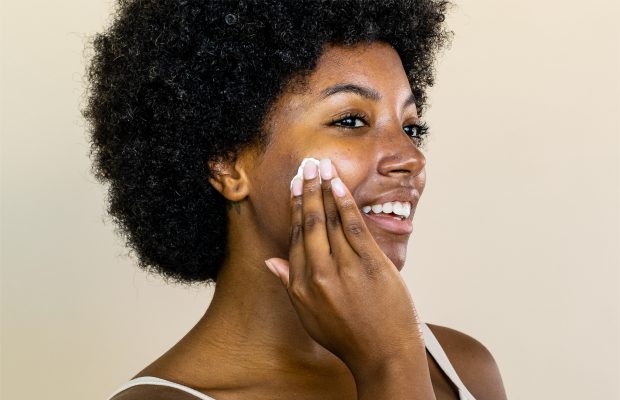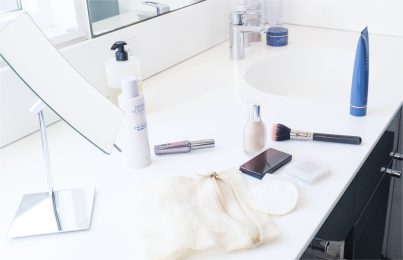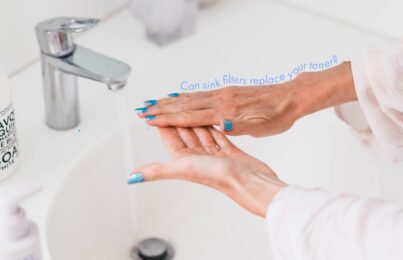Updated 06/13/23. If you deal with frequent breakouts, surely you’ve tried everything under the sun to get clearer skin. Hopefully, you’re seeing results with your efforts, but if not, you might be making a few common acne mistakes. As an esthetician with over 30 years of experience, I’ve seen people make these mistakes all too often. Read on to learn all 5 mistakes, plus, how to avoid them!
5 Common Acne Mistakes
1: Sticking With an Acne-Focused Skincare Routine Well Into Adulthood
There comes a time in life (usually around our mid-20s) when breakouts decrease in frequency. However, many people continue to use a breakout-focused skincare routine. They carry this routine over from their teen years, thinking that if they stop using that routine, the breakouts will return.
This is simply not accurate, as most people outgrow their breakouts due to hormonal changes. If you continue to use breakout-focused products, you run the risk of dryness and irritation. That’s why I recommend transitioning to a more preventative anti-aging skincare routine once you get to your mid-to-late 20s. Search for lightweight products formulated for your specific skin type. (Don’t know your skin type? Take the Skin Type Quiz to find out.)
Lightweight is the keyword. Many companies make anti-aging products that are too rich and heavy. Using these anti-aging products can actually end up blocking pores and causing breakouts. However, I can assure you that anti-aging products do NOT have to be thick or heavy to be effective. There are many effective ingredients formulated in lightweight bases that deliver amazing results.
If a breakout occurs, use a spot treatment. You can also regularly use a product with salicylic acid, like the AHA/BHA Blemish Control Cleanser to help keep pores clean and reduce the appearance of breakouts. These are both good ways to adapt your skincare routine so it fits what your skin needs NOW rather than what it may have needed a few years ago.
Read how to determine which products will work for you.
2: Using Spot Treatments Incorrectly
When a blemish appears, the goal is to get it to go away quickly, right? Most people have a variety of zit-zapping spot treatments in their bathrooms. They tend to apply these products the moment a blemish pops up, hoping to dry it out and eliminate it altogether. This is actually a common acne mistake and could be backfiring in a major way, making the blemish last longer. Let me explain.
Blemishes, like pustules or papules, have an infection within the pore which is why they are painful and red. The natural process is for the infection (pus from dead white blood cells) to come up and out through the skin’s surface. Your skin acts as an excretory system and this is your skin’s natural way of repairing itself. When you apply a drying spot treatment the moment a blemish appears, you’re drying out the surface, creating a layer of dead, flaky cells, which stops the infection from coming out. This traps it under the skin, making the visible blemish stick around longer than it would have otherwise.
Instead of reaching for a drying spot treatment the moment a blemish appears, wait until after the infection has come out. Here’s what to do. When the infection is at the surface and appears as a whitehead, gently press a warm, damp washcloth to it for two minutes. This will soften the skin and make the extraction easier. Next, wrap your fingers in a tissue and gently squeeze the whitehead twice. Only once the whitehead is removed should you dab on a drying spot treatment. This way, the spot treatment can permeate the pore lining and quickly dry up any remaining bacteria. I recommend using the Night Time Spot Lotion.
Read how to spot treat a pimple at every stage.
3: Skipping Out on Sunscreen
People who experience frequent breakouts are often so focused on dealing with their blemishes that they overlook one important product—sunscreen! Those with breakout-prone skin will generally shy away from sunscreen because traditionally, SPF formulas feel too heavy on their skin. And actually, some SPF formulas can worsen breakouts. However, if you skip out on sunscreen, you could be making your post-breakout marks linger.
Post-breakout marks are a big problem for some people. While most blemishes will go away anywhere from four to seven days after they appear, the discoloration that’s left behind can linger for much longer. And since pigment cells remain active in the presence of UV light, leaving your skin unprotected could cause those marks to linger even longer. Wearing a lightweight sunscreen like Weightless Protection SPF 30 will protect the damaged cells and give them time to recover and fade.
Read a complete guide on how to fade post-breakout marks.
4: Exfoliating Too Often
Exfoliating the skin is very effective for preventing clogged pores, but exfoliating too harshly or too often will only cause more inflammation and irritation in breakout-prone skin, ultimately damaging the skin’s moisture barrier. The moisture barrier is the outermost layer of the skin that helps retain water and provides protection from external aggressors, like bacteria and environmental debris. Think of it like your skin’s personal bodyguard. When the moisture barrier becomes damaged, small, invisible cracks are created in the skin. Through these cracks, moisture can easily escape and irritants can easily enter. The skin may start to feel tight, dry, and sensitive.
I recommend using an exfoliating acid serum with salicylic acid a few nights a week. Salicylic acid can penetrate the pore lining, helping to keep breakouts at bay. Using it a few nights a week will help keep pores clear without causing excess irritation.
Read my beginner’s guide to which exfoliant you should use and how often.
Mistake 5: Skipping Out on Moisturizer
People with breakout-prone skin worry that moisturizer will clog their pores and prevent their skin from being able to “breathe.” There are a few problems with this type of thinking. First, moisturizer does not directly cause breakouts. Breakouts occur when the cells that line the inner pores fail to shed properly and the pore becomes clogged. This process happens whether you moisturize or not. Second, the skin doesn’t respirate, so the concept of your skin being able to “breathe” is false.
Those with oily, blemish-prone skin must use moisturizer no matter what. Your skin needs sufficient water to keep it healthy and balanced. Skipping out on moisturizer disrupts the skin’s water levels, and this dehydration process stimulates more oil production. This could potentially cause even more breakouts, as it encourages the formation of bacteria and the build-up of dead cells within the pores. So, in this way, using the right moisturizer for your skin type can actually help lessen breakout activity. Trust me on this one. Moisturizer is a must for all skin types!
So there you have it—my expert advice on the five most common acne mistakes. Hopefully, this clarifies what will help you in your quest for clear skin, and just as importantly, what won’t.
Next, see eight surprising cleansing mistakes you need to stop making.
Celebrity Esthetician & Skincare Expert
As an esthetician trained in cosmetic chemistry, Renée Rouleau has spent 35 years researching skin, educating her audience, and building an award-winning line of products. Her hands-on experience as an esthetician and trusted skin care expert has created a real-world solution — products that are formulated for nine different types of skin so your face will get exactly what it needs to look and feel its best. Trusted by celebrities, editors, bloggers, and skincare obsessives around the globe, her vast real-world knowledge and constant research are why Marie Claire calls her “the most passionate skin practitioner we know.”



